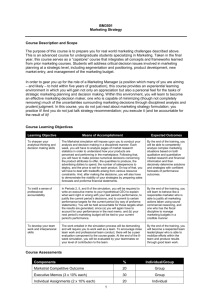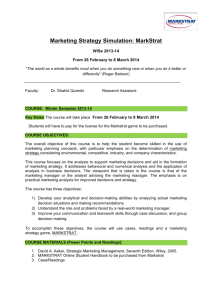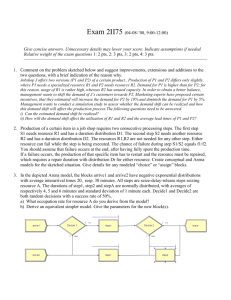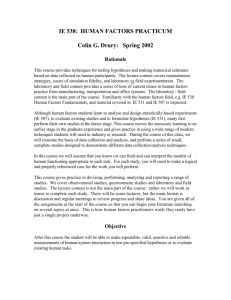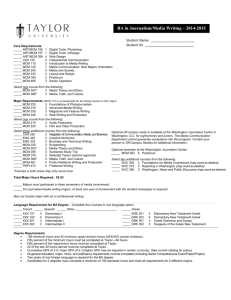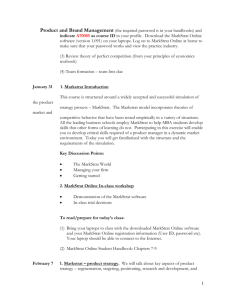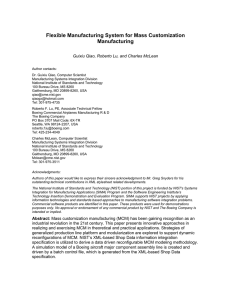Marketing Strategy Seminar 2015
advertisement
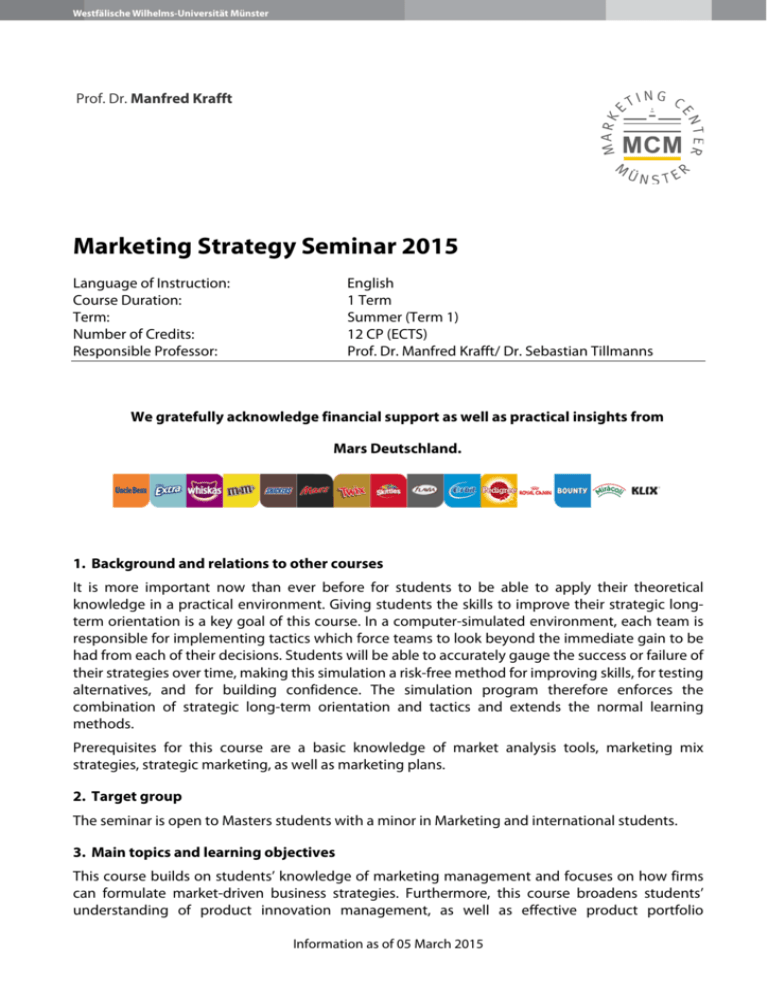
Westfälische Wilhelms-Universität Münster Prof. Dr. Manfred Krafft Marketing Strategy Seminar 2015 Language of Instruction: Course Duration: Term: Number of Credits: Responsible Professor: English 1 Term Summer (Term 1) 12 CP (ECTS) Prof. Dr. Manfred Krafft/ Dr. Sebastian Tillmanns We gratefully acknowledge financial support as well as practical insights from Mars Deutschland. 1. Background and relations to other courses It is more important now than ever before for students to be able to apply their theoretical knowledge in a practical environment. Giving students the skills to improve their strategic longterm orientation is a key goal of this course. In a computer-simulated environment, each team is responsible for implementing tactics which force teams to look beyond the immediate gain to be had from each of their decisions. Students will be able to accurately gauge the success or failure of their strategies over time, making this simulation a risk-free method for improving skills, for testing alternatives, and for building confidence. The simulation program therefore enforces the combination of strategic long-term orientation and tactics and extends the normal learning methods. Prerequisites for this course are a basic knowledge of market analysis tools, marketing mix strategies, strategic marketing, as well as marketing plans. 2. Target group The seminar is open to Masters students with a minor in Marketing and international students. 3. Main topics and learning objectives This course builds on students’ knowledge of marketing management and focuses on how firms can formulate market-driven business strategies. Furthermore, this course broadens students’ understanding of product innovation management, as well as effective product portfolio Information as of 05 March 2015 management in a dynamic market environment. The objectives of this course are to enable students to do the following: (1) Define a business strategy and goals, and select target products/markets in order to gain a profitable and sustainable competitive advantage. (2) Identify external threats and opportunities concerning customers, competitors, and the environment that a business might face. (3) Assess a business's strengths and weaknesses in relation to those of competitors, and determine external factors that might add to a competitive advantage. (4) Design and implement products to fit a target group, as well as market needs. (5) Apply analytical tools to market strategy development. 4. Teaching modes The course content will be course sessions and group work. Presence in all sessions is mandatory with a rate of 90%, and active course participation is required. The issues discussed in the course sessions and group work will serve as the accompanying simulation game’s qualitative and quantitative basis. The computer simulation game – Markstrat – is used as a pedagogical tool. Students’ participation in the game is therefore mandatory. The game objective is to increase the simulated company’s value, as expressed by the stock price index. This index consolidates key figures such as the market share and sales. The course takes the form of a survey of different frameworks and analytical tools, rather than comprehensively examining a specific marketing strategy. Students are advised to keep this in mind. 5. Group work Group work is a significant component (70%) of this course – and is required for certain papers, presentations, and the Markstrat simulation. Although the maximum group size is 5, the final number of participants will depend on the overall participation and will be announced after the official deadline (20 April 2015). Students may form their own workgroups (teams) but have to remain in the same group for the duration of the course. Students must submit a list of their group members’ names by 01 May 2015. Peer evaluation of the group: At the end of each group performance (Academic Paper Presentation, Simulation Game and Strategy Presentation), each group member must submit a peer evaluation form. This is to avoid group members causing problems with their free-riding. Each member is required to submit an "effort" rating (0%-100%) with regard to each member of his or her group. Each group member will then be given an “effort” rating, which will be calculated as the average of his or her group members’ ratings. For example, a 90% rating implies that the average of the group’s rating for that member was calculated as 90%. If no "effort" rating is provided, a default rating of 100% will be used. Students should note that the peer evaluation has separate sections that relate to each of the group’s performances. All sets of peer evaluations are due two days after each deadline and need to be sent via email to Fabian Kubik (f.kubik@uni-muenster.de). Only digital submissions will be accepted. Please use the peer evaluation form, which you can find in Learnweb. Information as of 05 March 2015 6. Course assignments and grading The following assignments have to be completed during the seminar and form part of the final grading. The assessment considers individual and group performances. Students are graded in respect of each assignment by means of a scoring system, which means that each student will receive points, thereby eliminating the possibility of a disadvantage arising from decimal rounding when the final grade is calculated. (a) Exam (individual performance; 45 Pts.) There is a 45-minute Markstrat rules test at the beginning of the course (04 May 2015). This test will relate to the Markstrat Online Student Handbook (see Section 9), as well as to the content of the introductory class. The exam will be taken electronically in LPLUS, and is divided into two parts: Section A is multiple choice and Section B contains open-ended questions. Students can find information about the LPLUS exams on the internet (http://www.wiwi.unimuenster.de/bdv/studierende/lplus.html). (b) Academic Paper Presentation (group performance; 45 Pts.) Each group will receive one academic paper related to the topics covered in this course. The assigned group needs to read the paper thoroughly and prepare a review for an in-class presentation (the other groups are also requested to read the paper). The presentations should take 15 min. + 10 min. for discussion and should be structured under the following headings: • • • • Summary and Key Findings Key Strengths and Key Weaknesses Managerial Relevance Discussion Please email your presentation (as a ppt or pptx file) to the instructor by 18:00 on the day before the review. (c) Simulation Game (group performance; 60 Pts.) The simulation game will be played by student teams and comprises eight decision rounds (see Section 5). The teams will compete with one another in a simulated business environment. Each team will evaluate the industry and marketing data and make product development, marketing mix (4Ps), and overall business decisions to achieve the highest stock price index for their simulated company. The fixed deadlines for making team decisions are not flexible. The final score depends on the overall team performance (indicated by the stock price index). The team with the highest score will earn the maximum possible points. The scores of all other teams will be relative to the top team’s performance. (d) Strategy Presentation (group performance; 45 Pts.) Each group will present their strategy and the resulting decisions over the course of the simulation. After each session, one group will present their strategy in front of the instructors. The strategy presentations should propose and justify the future strategy based on the current situation analysis. Groups should provide a clear statement of their Information as of 05 March 2015 objectives, their strategy for achieving those objectives, and the tactics they plan to use to implement their strategy in the next two rounds. They should present strong evidence that their objectives are reasonable and that – given their understanding of the customers’ perceptions and preferences – their strategy is the best. In addition the coverage and cost of each type of distribution channel should be provided, the positions and ambitions of their simulated firm’s competitors, as well as the strengths and weaknesses of their firm’s market position. The presentation should include the following topics: • • • • • Short Overview of the Market Situation Corporate Strategy Business Unit Strategies (this is an optional heading) Decisions Made for Next Period Contingency Plan After presenting their strategy and the upcoming decisions, each team must defend their strategy and actions against the instructors’ criticism. The time frame for presentations should be 15 min. + 10 min. for discussion. Please email your presentation (as a ppt or pptx file) to the instructor by 18:00 on the day before the strategy presentation. (e) Decision Area Description (individual performance; 45 Pts.) The Markstrat simulation game focuses on five areas of decision making, namely production planning, pricing decisions, communication, commercial team, and research & development. Each team member needs to choose one decision area (no double occupancy is allowed). In the decision area description paper, each student should provide a short description of his or her area of responsibility. In other words, the student should point out the decisions related to his or her area. Furthermore, the student must show which methods/data he or she uses to arrive at his or her decisions. Finally, the student must present area-related problems that occur due to his or her task assignment. The paper must not exceed 700 words (+/- 10%) and should include the following topics: • • • Description of the Area of Responsibility Decision Making Progress Description of Problems (f) Final Presentation (group performance; 60 Pts.) At the end of the course, each team must prepare a consultation-like presentation of their company. The group should consider this presentation as a briefing of the new team that will take over management. After presenting their consultation, each team must defend their strategy and actions against their fellow students’ criticism. The time frame for presentations should be 20 min. + 10 min. for discussion. The presentation should include the following elements: • • • • • Analysis of Past Performance Main Strategies Pursued Main Adjustments Made to Changes in the Environment Key Points Learned Through Past Successes and Failures Recommendations for the Future Information as of 05 March 2015 It is not necessary to give a period by period description of the team’s decisions. Rather, students should focus on insights that the team gained by mastering problems, as well as the general ideas behind decisions. Students should email their presentations (as a ppt or pptx file) to the instructor by 10:00 on the 22.06.2015. THE WRITTEN ASSIGNMENT “DECISION AREA DESCRIPTION” MUST BE SUBMITTED IN HARD COPY ON THE DUE DATE AT THE OFFICE OF THE INSTITUTE OF MARKETING. NO EMAIL SUBMISSION OF THESE ASSIGNMENTS WILL BE ACCEPTED. ALL ASSIGNMENTS SHOULD BE FORMATTED ACCORDING TO OUR GUIDELINES (SEE HOMEPAGE). Assignment Type Weights (in %) Points (Submission) Deadline individual 15 45 04.05.2015 Academic Paper Presentation group 15 45 18:00 prior to the presentation day Simulation Game group 20 60 see schedule Strategy Presentation group 15 45 18:00 prior to the presentation day individual 15 45 15.06.2015 group 20 60 22.06.2015 100 % 300 Exam Decision Area Description Final Presentation Total 7. Application Prospective students wishing to apply for this course should send a short, informal email with their name and student ID number to M. Sc. Fabian Kubik (f.kubik@uni-muenster.de). The deadline for applying is 20 April 2015, 23:59. Please consider the deadlines of the examination office (“PAM”). Registration at the PAM is a requirement for participation. Owing to license fees, the costs of the course are about €50. Thankfully, Mars Deutschland will pay for these costs. IT IS YOUR RESPONSIBILITY TO APPLY ON TIME. NO APPLICATIONS WILL BE CONSIDERED AFTER THE GIVEN DEADLINE. Information as of 05 March 2015 8. Course material Larréché, J.-C.; Gatignon, H.; Triolet, R. (2012): Participant Handbook - Strategic Marketing (Electronic Version), StratX International, Woburn. We will provide students with additional course material, as well as further required reading material at the start of the seminar. 9. Course schedule Date Time Assignment Room 20.04. 27.04. 04.05. 23:59 14:00-16:00 14:00-15:00 Deadline Application Introductory Course Exam MCM 08.05. 11.05. 12.05. 15.05. 18.05. 19.05. 22.05. 01.06. 14:00 14:00-16:00 14:00 14:00 14:00-16:00 14:00 14:00 14:00-16:00 SD* for decision period 1 Session 1 SD for decision period 2 SD for decision period 3 Session 2 SD for decision period 4 SD for decision period 5 Session 3 02.06. 05.06. 08.06. 09.06. 15.06. 14:00 14:00 14:00-16:00 14:00 14:00 15.06. 22.06. 14:00-16:00 12:00-18:00 SD for decision period 6 SD for decision period 7 Session 4 SD for decision period 8 SD for Decision Area Description Session 5 Final Presentation MCM MCM MCM H4 MCM MCM * SD = Submission Deadline MCM = Room 6, Am Stadtgraben 13-15 Pool WIWI2/3=ComputerLab im Juridicum Please keep in mind that there might be adjustments to the schedule. These will be announced on Learnweb (The password will be announced during the Introductory Course). Information as of 05 March 2015
